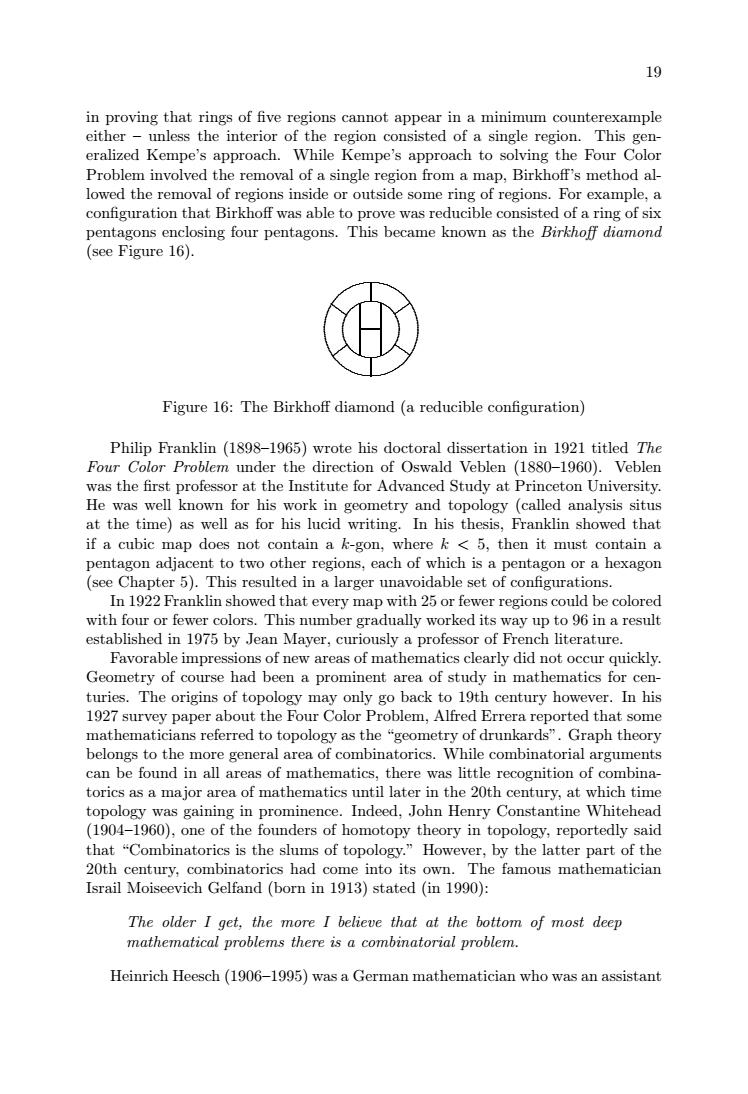正在加载图片...

19in proving that rings of five regions cannot appear in a minimum counterexampleeither - unless the interior of the region consisted of a single region.This gen-eralized Kempe's approach.While Kempe's approach to solving the Four ColorProblem involved the removal of a single region from a map,Birkhoff's method al-lowed the removal of regions inside or outside some ring of regions.For example, aconfiguration that Birkhoff was able to prove was reducible consisted of a ring of sixpentagons enclosing four pentagons. This became known as the Birkhoff diamond(see Figure 16).Figure16:TheBirkhoff diamond (a reducible configuration)Philip Franklin (1898-1965)wrote his doctoral dissertation in1921titled TheFourColor Problemunder thedirection of Oswald Veblen (1880-1960).Veblenwas the first professor at the Institute for Advanced Study at Princeton University.He was well known for his work in geometry and topology (called analysis situsat the time) as well as for his lucid writing. In his thesis, Franklin showed thatif a cubic map does not contain a k-gon, where k < 5, then it must contain apentagon adjacent to two other regions, each of which is a pentagon or a hexagon(see Chapter 5).This resulted in a larger unavoidable set of configurations.In1922Franklin showed thateverymapwith 25orfewer regionscould be coloredwith four or fewer colors.This number gradually worked its way up to 96 in a resultestablished in 1975 by Jean Mayer, curiously a professor of French literature.Favorable impressions of new areas ofmathematics clearly did not occurquickly.Geometry of course had been a prominent area of study in mathematics for cen-turies. The origins of topology may only go back to 19th century however. In his1927 survey paper about the Four Color Problem, Alfred Errera reported that somemathematicians referred to topology as the"geometry of drunkards". Graph theorybelongs to the more general area of combinatorics.While combinatorial argumentscan be found in all areas of mathematics, there was little recognition of combina-torics as a major area of mathematics until later in the 20th century, at which timeIndeed,John Henry ConstantineWhiteheadtopologywasgaininginp(1904-1960),one of thefounders of homotopytheory in topology,reportedly saidthat "Combinatorics is the slums of topology."However, by the latter part of the20th century,combinatorics had come into its own.Thefamous mathematicianIsrail Moiseevich Gelfand (born in 1913) stated (in 1990):The older I get, the more I believe that at the bottom of most deepmathematical problems there is a combinatorial problem.Heinrich Heesch (1906-1995)was a German mathematician who was an assistant19 in proving that rings of five regions cannot appear in a minimum counterexample either – unless the interior of the region consisted of a single region. This generalized Kempe’s approach. While Kempe’s approach to solving the Four Color Problem involved the removal of a single region from a map, Birkhoff’s method allowed the removal of regions inside or outside some ring of regions. For example, a configuration that Birkhoff was able to prove was reducible consisted of a ring of six pentagons enclosing four pentagons. This became known as the Birkhoff diamond (see Figure 16). . . .. .... ...... ......... .............. ....... ...... ...... .... ... .. ............................................................... . . .. .. .... ..... ...... ....... ........... ................... .......... ......... ....... ...... ..... .... .. .... . ..................................................................................................... . ..................... ...................... ..... ....................... ............... Figure 16: The Birkhoff diamond (a reducible configuration) Philip Franklin (1898–1965) wrote his doctoral dissertation in 1921 titled The Four Color Problem under the direction of Oswald Veblen (1880–1960). Veblen was the first professor at the Institute for Advanced Study at Princeton University. He was well known for his work in geometry and topology (called analysis situs at the time) as well as for his lucid writing. In his thesis, Franklin showed that if a cubic map does not contain a k-gon, where k < 5, then it must contain a pentagon adjacent to two other regions, each of which is a pentagon or a hexagon (see Chapter 5). This resulted in a larger unavoidable set of configurations. In 1922 Franklin showed that every map with 25 or fewer regions could be colored with four or fewer colors. This number gradually worked its way up to 96 in a result established in 1975 by Jean Mayer, curiously a professor of French literature. Favorable impressions of new areas of mathematics clearly did not occur quickly. Geometry of course had been a prominent area of study in mathematics for centuries. The origins of topology may only go back to 19th century however. In his 1927 survey paper about the Four Color Problem, Alfred Errera reported that some mathematicians referred to topology as the “geometry of drunkards”. Graph theory belongs to the more general area of combinatorics. While combinatorial arguments can be found in all areas of mathematics, there was little recognition of combinatorics as a major area of mathematics until later in the 20th century, at which time topology was gaining in prominence. Indeed, John Henry Constantine Whitehead (1904–1960), one of the founders of homotopy theory in topology, reportedly said that “Combinatorics is the slums of topology.” However, by the latter part of the 20th century, combinatorics had come into its own. The famous mathematician Israil Moiseevich Gelfand (born in 1913) stated (in 1990): The older I get, the more I believe that at the bottom of most deep mathematical problems there is a combinatorial problem. Heinrich Heesch (1906–1995) was a German mathematician who was an assistant